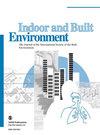Numerical modelling of ventilation strategies for mitigating cough particles transmission and infection risk in hospital isolation rooms
IF 3.2
3区 工程技术
Q2 CONSTRUCTION & BUILDING TECHNOLOGY
引用次数: 0
Abstract
This study used numerical modelling to analyze air velocity, cough particle distribution and infection risks in an isolation room. It investigated air change rates, inlet/outlet vent positioning and assessed various ventilation rates and outlet configurations for reducing infection risks. Quantitative assessments revealed different particle escape timings. In Case 1, smaller particles (2–4 μm) took 8.2 s to escape, while in Case 2, this time extended to 22.7 s. At 48 ACH, there were significant improvements in removing particles of various sizes, particularly those sized 2–4 μm, 16–24 μm and 40–50 μm, reducing the infection risk. The use of the Wells-Riley model highlighted considerable reductions in infection probabilities with higher ACH. Specifically, infection risks were reduced to 5% in Case 1 and 17% in Case 2, underscoring the marked advantage of Case 1 in reducing infection probabilities, particularly for smaller particles. Furthermore, escalated ACH values consistently correlated with decreased infection probabilities across all particle sizes, highlighting the pivotal role of ventilation rates in mitigating infection risks. The study comprehensively investigated the distribution of air velocity, dynamics of cough particles and infection risk associated with different ventilation strategies in isolation rooms.缓解医院隔离室咳嗽微粒传播和感染风险的通风策略数值建模
这项研究利用数值建模来分析隔离室中的空气流速、咳嗽颗粒分布和感染风险。研究调查了换气率、入口/出口通风口的位置,并评估了各种通风率和出口配置,以降低感染风险。定量评估显示了不同的颗粒逃逸时间。在案例 1 中,较小的微粒(2-4 μm)需要 8.2 秒才能排出,而在案例 2 中,这个时间延长到了 22.7 秒。在 48 ACH 的情况下,在清除各种大小的微粒,尤其是 2-4μm、16-24 μm 和 40-50 μm 的微粒方面有了显著改善,从而降低了感染风险。Wells-Riley 模型的使用突出表明,ACH 越大,感染概率就越低。具体来说,情况 1 的感染风险降低到 5%,情况 2 的感染风险降低到 17%,这表明情况 1 在降低感染概率方面具有明显优势,特别是对于较小的颗粒。此外,在所有颗粒大小的情况下,ACH 值的升高与感染概率的降低始终相关,这突出了通风率在降低感染风险方面的关键作用。该研究全面调查了隔离室中不同通风策略下的气流速度分布、咳嗽颗粒动态和感染风险。
本文章由计算机程序翻译,如有差异,请以英文原文为准。
求助全文
约1分钟内获得全文
求助全文
来源期刊

Indoor and Built Environment
环境科学-工程:环境
CiteScore
6.40
自引率
25.00%
发文量
130
审稿时长
2.6 months
期刊介绍:
Indoor and Built Environment publishes reports on any topic pertaining to the quality of the indoor and built environment, and how these might effect the health, performance, efficiency and comfort of persons living or working there. Topics range from urban infrastructure, design of buildings, and materials used to laboratory studies including building airflow simulations and health effects. This journal is a member of the Committee on Publication Ethics (COPE).
 求助内容:
求助内容: 应助结果提醒方式:
应助结果提醒方式:


